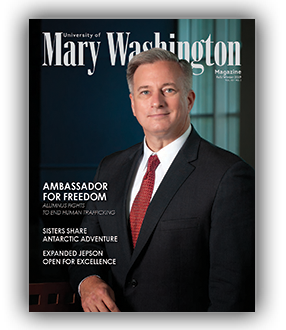The following remarks are excerpted from a Q&A with President Troy Paino that focused on how he used feedback from a Great Colleges to Work For survey of university employees completed in 2016, a year when UMW did not make the cut. Having just taken the helm at Mary Washington then, President Paino used the results as a platform for change and setting of priorities. In only three years, his initiatives paid off – of 152 four-year institutions nationwide that participated in this year’s survey, UMW was among 60 selected as a Great College to Work For.
Below are excerpts of Troy Paino’s responses in the Q&A:
The survey gave me an important diagnostic tool to better understand how the people who work here felt about the state of the university. To move UMW forward, we needed the faculty, staff, and administrators to be fully invested in the school’s strategic direction. To get this sort of investment, our senior leadership had to build trust and instill hope. The 2016 survey showed me that our priorities were improving communication – and that includes listening; more clearly articulating a vision that resonates with the values, mission, and culture of UMW; and addressing salaries that had fallen behind the market.
The results of the 2016 survey gave us a jumping-off point to engage the UMW community around the challenges facing the university. Openly talking about the survey’s results demonstrated our desire to have deeper conversations around how people were feeling about the workplace, whether they felt valued or not, and what their hopes and dreams were for UMW. These conversations laid the foundation for what would ultimately become our university’s vision for the future.
“President Paino has set a vision to move us into a new era where we can maintain our commitment to the liberal arts while also realizing our mission to provide access to all students. I am inspired by his leadership.”
– UMW employee feedback,
2019 employee survey
I really got a sense of the heart and soul of this place as people not only opened up about their disappointments and frustrations, but also about what gave their work meaning and why they invested so much of themselves in what they do for our students. It allowed the vision we created to be very organic, and frankly, made it easy to sell. I actually kept a summary of the 2016 survey results on my desk as a reference and reminder of what leadership needed to do to build more trust.
Did we always get it right? No. As I start my fourth year here, I am still looking for the most effective way to communicate and have those critically important conversations with the UMW community about the difficult issues facing the university. While we have made progress on a number of dimensions, and our employees indicate we are moving in a positive direction, we still have a long way to go.
We regularly use the 2016 results to remind ourselves of opportunities for growth. It is important to remember that while some of what the faculty, staff, and administrators were telling us was difficult to hear, the leadership teams both before and after my arrival had the courage to listen. It would have been easy to become defensive or dismissive, but my leadership team chose the more difficult and courageous path. They listened, reflected, and then committed themselves to action.
It is also important to remember that the results of that survey gave us a glimpse of what is amazing about this university. Despite the challenges, the people who work here love this place, love each other, and love our students. Those relationships and their dedication are what really make Mary Washington a special place.

